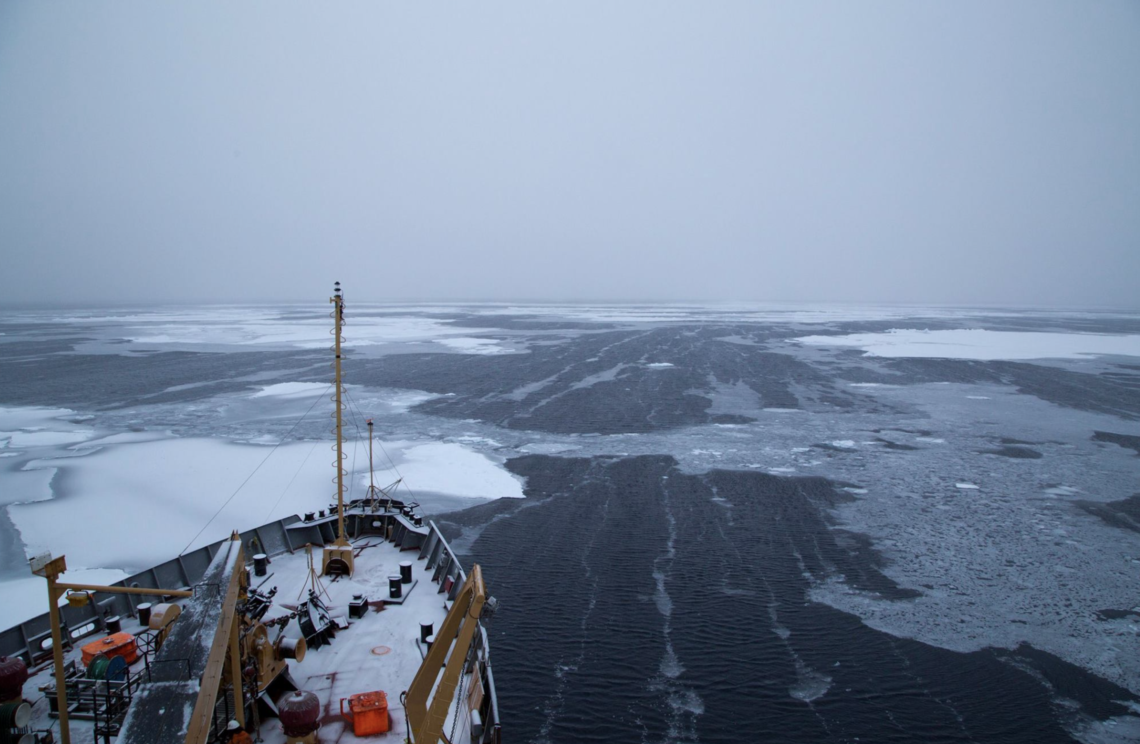Reviewed by Alex SmithNov 30 2022
A warming climate seems responsible for a decrease in sea ice in the Arctic Ocean, where the loss of sea ice has significant economic, ecological, and climate effects.
 A ship-based view of the Arctic Ocean in October 2015, when the ocean’s surface is beginning to freeze. In January, when the massive 2022 cyclone occurred, large sections of the Arctic Ocean would be covered in a layer of sea ice. Image Credit: Ed Blanchard-Wrigglesworth/University of Washington.
A ship-based view of the Arctic Ocean in October 2015, when the ocean’s surface is beginning to freeze. In January, when the massive 2022 cyclone occurred, large sections of the Arctic Ocean would be covered in a layer of sea ice. Image Credit: Ed Blanchard-Wrigglesworth/University of Washington.
Additionally, weather events as a result of climate change tend to affect the sea ice from week to week.
The most powerful Arctic cyclone ever noted poleward of 70° north latitude struck in January 2022 northeast of Greenland. A new examination headed by the University of Washington displays that while weather forecasts precisely anticipated the storm, ice models seriously undervalued its effect on the sea ice of the region.
The study reported in October in the Journal of Geophysical Research–Atmospheres indicates that present models undervalued the effect of big waves on ice floes present in the Arctic Ocean.
The loss of sea ice in six days was the biggest change we could find in the historical observations since 1979, and the area of ice lost was 30% greater than the previous record. The ice models did predict some loss, but only about half of what we saw in the real world.
Ed Blanchard-Wrigglesworth, Study Lead Author and Research Assistant Professor, Atmospheric Sciences, University of Washington
Precise sea ice forecasts are known to be significant safety tools for Northern communities, mariners, and others functioning in Arctic waters. Also, the precision of forecasts in the Arctic Ocean has wider effects.
The skill of a weather forecast in the Arctic affects the skill of weather forecasts in other places.
Ed Blanchard-Wrigglesworth, Study Lead Author and Research Assistant Professor, Atmospheric Sciences, University of Washington
The January 2022 cyclone consisted of the least pressure center estimated as satellite records began in 1979 above 70° north.
This was known to be an extreme version of a normal winter storm. The scientists did not find a trend in the power of intense Arctic cyclones since 1979, and the sea ice area was next to the historical normal for that region just before the storm had hit.
When the storm occurred, record winds howled over the Arctic Ocean. The waves increased to 8 m (26 ft) tall in open water and remained amazingly strong as they traveled via the sea ice.
The ice heaved 2 m (6 ft) up and down next to the edge of the pack, and NASA’s ICESat-2 satellite displays that the waves reached as far as 100 km (60 miles) toward the center of the ice pack.
Six days following the storm struck, the sea ice had thinned considerably in the affected waters north of Russia and Norway, in places losing over half a meter (around 1.5 ft) of thickness.
It was a monster storm, and the sea ice got pummeled. And the sea ice models didn’t predict that loss, which suggests there are ways we could improve the model physics.
Melinda Webster, Study Second Author and Research Assistant Professor, University of Alaska Fairbanks
Webster starts a research position at the UW Applied Physics Laboratory in the new year.
The new analysis performed shows that the atmospheric heat from the storm constituted a small effect, implying few other mechanisms were to blame for the ice loss.
Blanchard-Wrigglesworth indicates that chances include sea ice that was thinner prior to the storm hit compared to models that had estimated; that the storm’s waves broke up ice floes more strongly compared to models predicted as they entered deep into the ice pack; or that waves agitated deeper, warmer water and brought it into contact with the sea ice, thereby melting the ice from below.
The sudden ice loss that happened despite a precise storm forecast indicates that this is an area where models could be enhanced. The scientists hope to track future storms to spot exactly what is headed to the considerable sea ice loss, possibly by placing sensors in the path of an approaching storm in the future.
While this storm does not seem to emerge to be linked to climate change, the rise of open water as sea ice melts is enabling bigger waves that are eroding Arctic coastlines. Scientists said that those waves could also impact the leftover sea ice pack.
Blanchard-Wrigglesworth stated, “Going into the future, this is something to keep in mind, that these extreme events might produce these episodes of huge sea ice loss.”
The other co-authors of the study are Linette Boisvert at NASA, Chelsea Parker at NASA and the University of Maryland, and Christopher Horvat at the University of Auckland and Brown University. The study was financially supported by NASA, the U.S. Navy’s Office of Naval Research, and Schmidt Futures.
Arctic waves
Waves travel through sea ice in the Arctic Ocean, as seen from a ship in October 2015. Image Credit: Ed Blanchard-Wrigglesworth/University of Washington
Journal Reference:
Blanchard-Wrigglesworth, E., et al. (2022) Record Arctic Cyclone of January 2022: Characteristics, Impacts, and Predictability. JGR Atmospheres. doi.org/10.1029/2022JD037161.